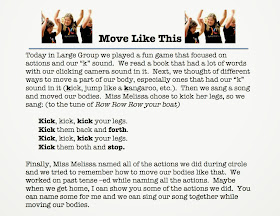I recently stumbled across "I Am Hiding" by Mercer Mayer and got a little too excited about how perfect it would be for targeting several language concepts. Each page is very simple, with repetitive text that could be used for working on the pronoun, "I," the be-auxiliary, "I am," action words, and verb+ing. It could even be used for targeting other pronouns such as "he" and "she" as you describe what the brother/sister is doing.
Here are some simple ways to work on each of these targets as you read this book with your child, create a group activity for your class, or work with a student in therapy:
Pronouns:
- When targeting "I" just have the child repeat the phrase on each page word for word. ("I am sneaking.")
- If the target is he/she, describe what the brother or sister is doing and have the child repeat the phrase. Or ask them, "What is he doing?" ("He is resting." "She is looking.")
Be-Auxiliary ("I am"):
- Have the child repeat each phrase in the book. ("I am hopping")
- After reading each page, have the child act it out and describe what they are doing. ("I am creeping.")
Action words/verb+ing:
- Label each action for the child and have them repeat it.
- If they are at the phrase level, have them repeat each sentence after you read it.
- Again, simply having them act out the action on the page, and then label it is a great way to work on action words.
Large Group/Small Group:
- Give each child a copy of the book so they can follow along as you read it.
- Act out the actions on each page and have the children repeat the phrase from the book.
- Have the children describe what other children are doing to target the pronouns he/she. "What is Sarah doing" "She is jumping." or "Who is looking" "She is!")
- Play hide-and-go seek at the end and have the child 'seeking' use the phrase, "I am" as they are looking. ("I am looking." "I am walking." "I am stretching")
- Once they find the child that was hiding, ask the class, "Who did he find?" Then have the class repeat either "her" or "him" to target those pronouns. If you were still working on children's names, you could have them say the child's name.
For additional activities, Speaking of Speech has a great section on targeting verbs, including "I am."


































